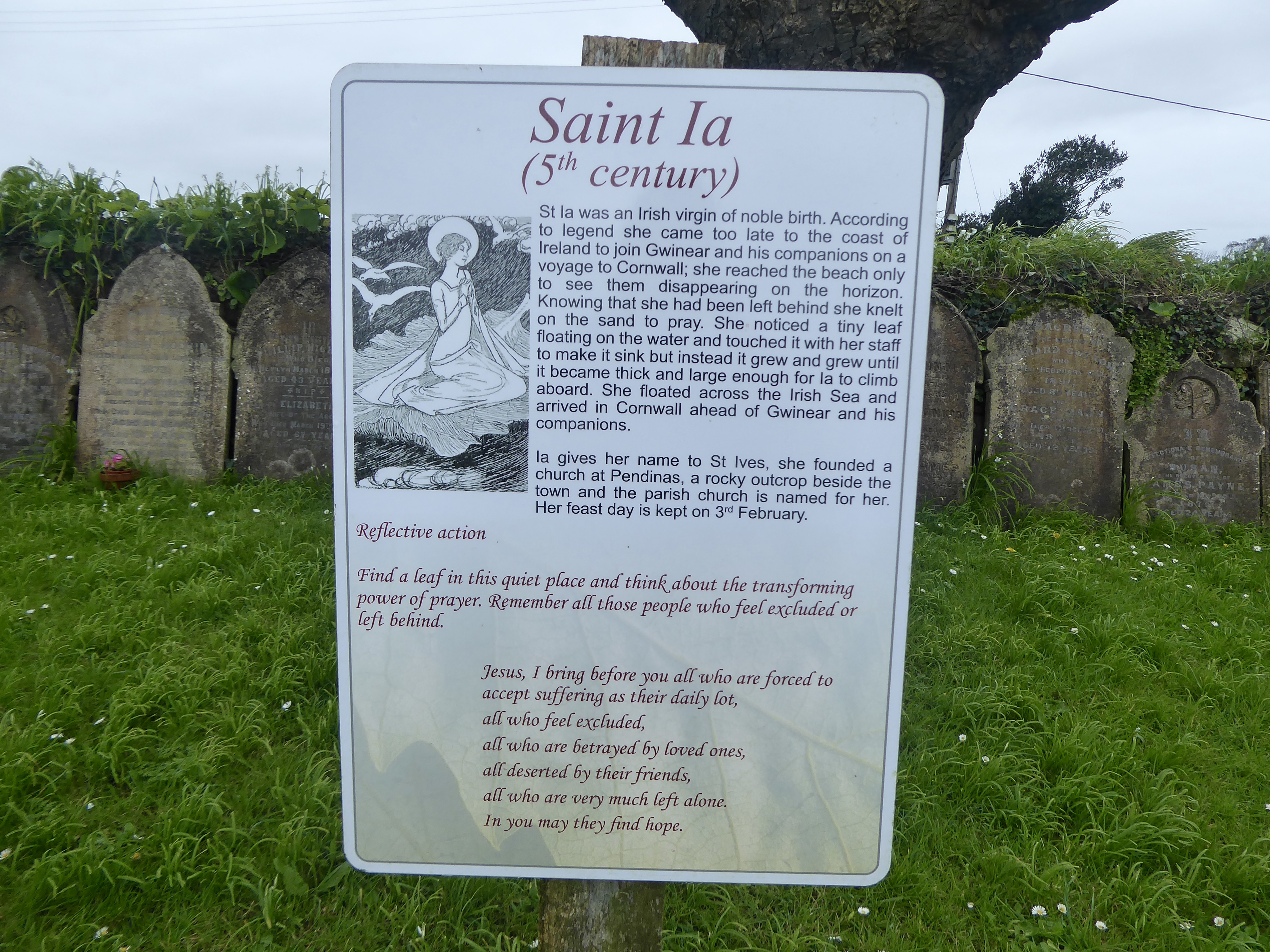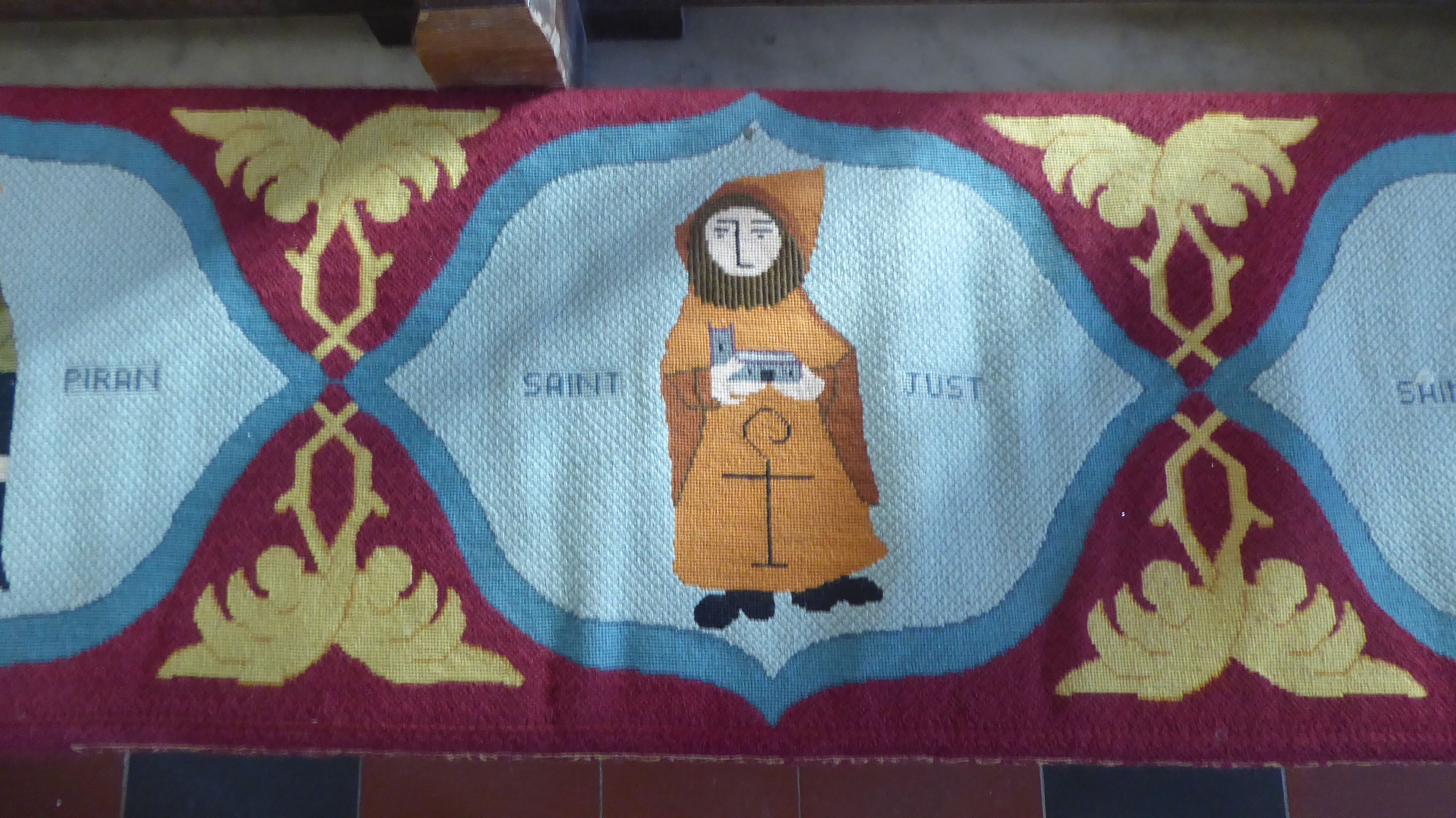
Celtic saints names beginning H-K
HOLYWELL Nr CRANTOCK
There is a holy well and fishponds full of water which had healing properties. There is another well in a cave in Holywell Bay which is accessible at low water. It’s not clear which saint this is associated with.
IA:
Irish female
St Ives (formerly known as Porth Ia)
Lanivet
Wendron
Troon has a church and well dedicated to Ia.
There is a well at Venton Ia nr Porthmear Beach (St Ives)
She came over from Ireland on a leaf (coracle?) and settled on the mouth of the River Hayle where St Ives is. She was of noble birth, born in 430AD. Converted by Patrick and a disciple of Finnbarr. Legend goes that she missed the boat for an expedition to Cornwall but wept so much an ivy leaf grew big enough to bring her over where she settled inland. A friendly King, Dinan, built a church for her. She established her cell there at St Ives.

ILDIERNA:
female
She led a mixed community of male and female and was Welsh or Irish.
ILLTUD:
male
About 400AD. He was taught by Germanus along with Patrick and founded a monastery at Llantwit Major. A church remains today on the site. He’s associated also with Samson, and Dubricius.
ISSEY: (Itha, Ida) Welsh female
St Issey
Mevagissey
Brychan’s daughter
She founded a church between Wadebridge and Padstow at St Issey.
Was baptised with the name Dairdre, which means an insatiable desire for the living water of Heavenly truth.
She was known for her tact, perception, broadmindedness, miracles, and gift of prophecy. She wrote a song to baby Jesus. She was prioress to nuns in Limerick and foster mother to Irish Brendan. She said there are 3 things pleasing to God: 1: resignation to the Divine will 2: simplicity 3: large heartedness and 3 things most hateful to God: 1: churlishness, 2: love of evil, greed or gain.
JULITTA Welsh male
Brychan's son

Saint Julitta, or Saint Juliot, is a male Celtic saint to whom two Cornish churches are dedicated. He is believed to have settled at the site of Tintagel Castle at the end of the 5th century and established a small monastic community. In some accounts he is a member of the children of Brychan and St Nectan and the holy female hermit St Keyne, are thought to have been his companions. He is the patron of the parish churches of St Juliot and of Lanteglos by Camelford. The Norman chapel of Tintagel Castle is dedicated to St Julitta. At Jetwells near Camelford is a holy well. Jetwells derives from "Juliot's well". Grid ref SX129912 St Juliot’s, Boscastle, PL12 5ER’
JUST
St Just-in-Penwith nr Land’s End
St Just-in-Roseland
They had a reputation for being an aggressive rival with St Keverne.
There is a Holy Well at St Just in Roseland by the church and one in the village called Venton Gassic.

KEA
St Kea was a late 5th century Celtic saint from the Brythonic speaking parts of southern Scotland and northern England. He was mainly associated however with Cornwall, Devon and Brittany. It is thought there was a large Christian Celtic community based at Kea where he established a church. St Fikius, who is associated with Philleigh in Cornwall was a companion of Kea. There are two sources of information about Kea, one a hagiographic account by Maurice of Cleder in the 17th century, as well as an incomplete 16th century Cornish language play discovered in 2000.
It is said he was the son of King Lleuddun Luyddog of Lothian in Scotland and was a bishop in northern Briton before coming south to become a hermit, firstly in Wales and then Somerset, Devon and Cornwall. He founded churches at Street, Somerset and Lamdkey, Devon (holy place of Kea). He finally settled at Old Kea in Cornwall, on the south coast, giving his name to the settlement.
He was harassed by Cornish King Teudar when he sheltered a deer, giving it protection from the king hunting it. His oxen were confiscated as a result and the deer was used to plough instead.
Later he travelled to Brittany where he died at another place bearing his name, St Quay.
Kea is also associated with King Arthur, being called back from .Brittany to negotiate peace between Arthur and his nephew Mordred. Kea criticises Guinevere for her adultery with Mordred leading her to repent.
A different hagiographic legend has Kea as Irish and as he was watching other missionaries depart he prays not to be left behind. At that moment the granite slab he’s standing on begins to float and takes him across the sea. It’s a parallel story to that of St Piran.
KEVERNE
St Keverne
An aggressive rival with Just
KEYNE- Welsh
(Alternative names, Keane, Kayane, Keyna, Cenau, Cenedion, Deinwen)
Died 490AD
There is only one written account of her life (Vita Sanctae Keynae) but this was 800 years after she lived so is not considered accurate. However, some things are known about her.
St Keyne was one of King Brychan’s daughters, apparently very beautiful and as a result had many offers of marriage which she refused. She was known for her holiness and piety, as well as her purity, having taken a vow of chastity and lived as a hermit most of the time. In Welsh she is known as Cain Wyry which means Keyne the Maiden, or Virgin.
There are many dedications to St Keyne in South Wales, Anglesey, Somerset, Hertfordshire and Cornwall. She is said to have travelled widely and founded many prayer oratories in Wales, including Llangeinor in Mid Glamorgan, Llangunnor and Llangain in Dyfed and Rockfield (Llangennon) in Runston Gwent. There is a side chapel in Brecon cathedral dedicated to her. I’ve had amazing encounters with God in this particular chapel and have been returning for several decades.
In Cornwall St Keyne village is named after her and her holy well is still there, plus the church is built on a ‘lan’ indicating an early Christian holy settlement. The River Kenwyn in Truro is also attributed to her name and she is the patron saint of St Martin by Looe (Penndrumm).
One interesting legend is from Keynsham in Somerset where it’s said she lived on the banks of the River Avon. It was swarming with serpents and uninhabitable as a result. She prayed fervently and the serpents were turned to stone and the land became habitable. It’s easy to dismiss this type of story as mere legend yet it has survived over 1500 years and one assumes there is a grain of truth within it. Afterall, these Celtic Christians moved in supernatural power and there are many such stories existing.
In around 490AD she visited her nephew St Cadoc at St Michael’s Mount in Cornwall and stayed there awhile before returning to Wales. A healing spring marked her final prayer oratory and where she died. The likely spot for this is Llangeinor in Glamorgan. It is said the healing properties of the spring remain.